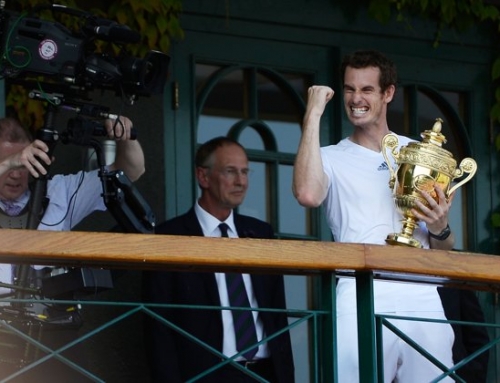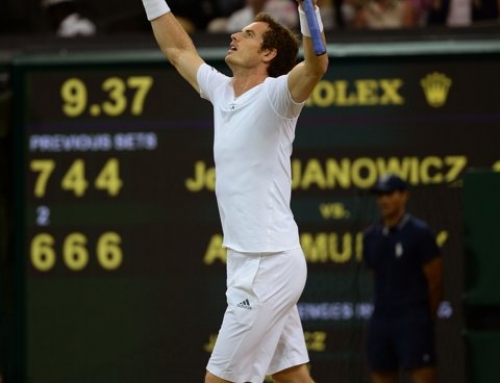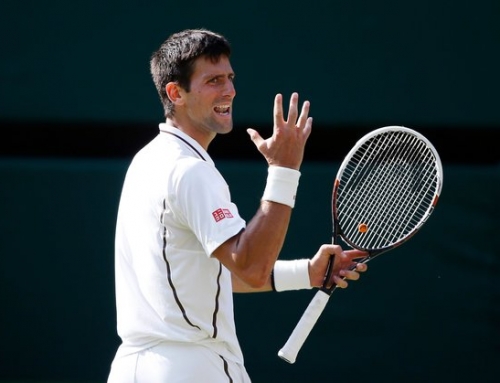 Ah, Wimbledon Wednesday, the day all the men play their quarterfinal matches. Unlike previous years, the quarterfinal matches were more of a surprise. No Nadal, no Federer, and no Tsonga will do that to a tournament.
Ah, Wimbledon Wednesday, the day all the men play their quarterfinal matches. Unlike previous years, the quarterfinal matches were more of a surprise. No Nadal, no Federer, and no Tsonga will do that to a tournament.
The matches are played two at a time. Two played on Centre Court, and two played on Number 1 court. Despite Djokovic being the number 1 player in the world, he was relegated to Number 1.
His opponent for the quarterfinals was a familiar foe: Tomas Berdych. Berdych played a strong match, but Djokovic is playing his strongest stretch of tennis in this tournament, and possibly all year long. Even so, the two played even throughout the first set without a break. The tiebreak was close, but finally Djokovic won at the end, to take the tiebreak 7-5.
Berdych then started off the second set strong with a 3-0 lead with two breaks, surely enough for him to even up the match. However, Djokovic broke back 3 times and took the set, 6-4. Djokovic then took the third set comfortably 6-3 and the match.
The other match played at the same time was Juan Martin del Potro and David Ferrer. Both came into the match banged up some. del Potro hyper-extended his knee in the previous round and twisted his ankle. His appearance was a bit in doubt, but he showed up. Early in the match, he hyper-extended his knee a second time, and it was thought he might not finish the match. However, he took some painkillers, and was ready to play once again. David Ferrer’s weakest surface is grass, but last year, he won a grass event, and made it to the quarterfinals where he pushed Murray to four sets. This year, he’s dropped sets but still found ways to win.
With both players less than their best, it was del Potro that was able to use his power to get breaks. Two in the first, one in the second, and a running winner down the line to take a tiebreak in the third. Had Ferrer managed to win the third set, it would have been questionable whether he could have won or completed the match.
Both matches ended roughly the same time, about 4:30 London time.
Lukasz Kubot and Jerzy Janowicz followed the Djokovic-Berdych match. The best a Polish male had ever done was reach the quarterfinals, but with two playing each other, one was guaranteed (short of a double default) a place in the semifinals. Of the two, Janowicz was considered the favorite. He was the higher ranked player. He has a huge serve, and despite his 6’8″ height, he has unusually good finesse to complement the power. Kubot, meanwhile, is more of a journeyman who has been on the tour a while but never climbed its upper echelons.
Despite the difference in rank, the sets were all pretty close with a single break determining each set, in the 7-5, 6-4, 6-4 win.
At the same time this match was being played, favorite son, Andy Murray was scheduled for Centre Court against Fernando Verdasco. If Verdasco had the kind of mental will that makes Nadal so tough, he may have been the number 1 player. There was some thought, after his performance in the 2009 Australian Open where Verdasco beat Murray in the quarters then played a wondrous five-setter against Nadal in the semis, that Verdasco would be a fixture in the top ten, much like Berdych and Tsonga are fixtures now.
Verdasco, after all, has a huge lefty forehand and a decent serve to boot. He’s like Feliciano Lopez who has somewhat similar skills, but Verdasco hits his backhand with two hands while Lopez often plays the one-handed slice. Verdasco has trained with Gil Reyes, and therefore he’s one of the fittest and strongest men on tour. But, it’s his brain that is often at question, whether he can play intelligent points, and not be prone to crazy errors. In a way, Verdasco’s strength, the desire to hit with power anywhere on the court without thinking is also his weakness. He can hit stretches where he misfires, and thus loses matches when he shouldn’t.
Recently, Verdasco started using a Babolat racquet as well as hired a new coach in Ricardo Sanchez. Sanchez has primarily coached women including Nadia Petrova and Sabine Lisicki. With his new team, Verdasco reached the quarters of Eastbourne losing to fellow lefty and former doubles parner, Feliciano Lopez.
Early in the match, Murray struggled returning Verdasco’s serve. Although Verdasco didn’t hit that many aces, many of his serves came back unreturned. Thus, early in the first set, the two were even. Murray then played a bad game, and all of a sudden, Verdasco had a break and the first set.
The second set started off better for Murray with an opening break, but then he got broken back twice. Shots that are normally quite comfortable for the Scot were hit with nerves, as shots sprayed all over, and it didn’t look good given how good Verdasco was hitting.
Still, the Murray of today is not the Murray of 2009 and the Verdasco of 2009 is not the Verdasco of today. Verdasco began to cool down, and Murray began keeping more shots in play. Murray was able to break twice to comfortably take the third set. The fourth set was closer with Murray having to making some key holds, before taking the sets, 6-4. That pushed the match into a fifth set.
For the most part, Murray was holding easily, but there was a 0-30 game that looked edgy before Murray won 4 points in a row and made the held. Meanwhile, Murray struggled to get deep into Verdasco’s games with his big serve and big groundies. He needed a sloppy game from Verdasco which came at 5-all.
Murray was forced to slice shots deep, and try to extend rallies hoping errors would come, and eventually he secured the break to lead 6-5, but he still had to serve it out. A few more errors allowed Murray to have a nice 40-0 lead and although he gave up a point, he won the match when a Verdasco shot went long. What really helped Murray in the fifth, especially late, was to move Verdasco around. Early in the first set, Murray was content to rally backhand to backhand instead of moving Verdasco around, as if he felt nervous challenging the forehand.
Once Murray closed out the match, he raised his arms more in relief than anything else.
When asked about the match afterwards, Murray felt that he made low percentage shots at the start of the match and improved his decision making as time went along.
Up next for Murray is the 22 yr old Pole with the huge serve. Murray has played Janowicz twice, once in a Davis Cup tie when Janowicz was probably 19 years old, and once in the Paris Masters last year. The Paris Masters lead to a number of upsets, many caused by Janowicz who reached his first Masters 1000 final. Unlike previous years where there was a week between Paris and the year-end championships in London, last year, there was no such rest week.
Thus, a number of players, including Murray, may have strategically lost. Murray was indeed, in a pretty comfortable position, in the match before Janowicz finally took the second set tiebreak and rolled in the third set. While Janowicz had not produced that kind of tennis since Paris, clearly, reaching the Wimbledon semi is a big step to fulfilling that talent (he did reach the quarterfinals of Rome).
Looking ahead to the finals, the big question is whether del Potro will play because he hyper-extended his knee again, and if he does, how effective will he be, and even if he’s effective, does it matter against Djokovic. In the other semi, the question is whether Murray can handle the Janowicz power and whether Janowicz will get nervous playing in the semi and whether Murray can clamp down and play the kind of tennis that lead him to this point minus that blip against Verdasco.
Semifinals played on Friday.







![[Wimbledon, Day 3] Federer’s 36 Slam quarterfinal streak ends with 2nd round loss to Stakhovsky](https://www.essentialtennis.com/wp-content/uploads/2013/06/20130626stak-500x383.jpg)